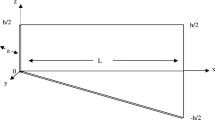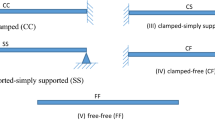Abstract
In recent years, stepped beam resonators have found broad application in MEMS/NEMS devices. A beam resonator with an undercut at the support, produced due to isotropic etching of the supporting substrate during fabrication, has also been characterized as stepped beam in the literature. The present study deals with thermoelastic dissipations of clamped–clamped stepped beam resonators under adiabatic surface thermal conditions having j (j = 1, 2, …., n) number of sections defined by (j − 1) number of steps along the length. Numerical results are obtained for three different types of stepped beams of rectangular cross-section having single step such as beams with cross-sectional change at the step only in lateral direction (type-1), in bending direction (type-2), and in both lateral and bending directions (type-3) where the section on the right of the step possesses smaller cross-sectional size compared to the other. The obtained results show that Q-factors vary significantly with step positions in all the three types of stepped beams. For constant length, the Q-factor increases in the type-1 while it decreases in other two types of stepped beams as the step position moves from the left support to the right along the length. Moreover, Q-factors in a type-1 stepped beam depend on the widths of different sections and can be higher than a uniform beam of same thickness for some particular step positions. For most common lengths of stepped beams in real applications with the step close to the left support, type-1 stepped beams provide higher quality factors than the other stepped beams provided that they have the same cross-sectional area.












Similar content being viewed by others
References
Behreyni B, Shafai C (2006) Application of twin-beam structures for estimation of material properties and sensor fabrication. Can J Electron Comput Eng 31:85
Cimalla V, Niebelschütz F, Tonisch K, Foerster Ch, Brueckner K, Cimalla I, Friedrich T, Pezoldt J, Stephan R, Hein M, Ambacher O (2007) Nanoelectromechanical devices for sensing applications. Sens Act B 126:24–34
Cleland AN, Pophristic M, Ferguson I (2001) Single-crystal aluminum nitride nanomechanical resonators. Appl Phys Lett 79:2070
Demirci MU, Nguyen CTC (2003) Higher-mode free–free beam micromechanical resonators. In: Proceedings of 2003 IEEE International Frequency Control Symposium, Tampa, Florida, pp 810–818
Ekinci KL, Roukes ML (2005) Nanoelectromechanical systems. Rev Sci Instrum 76:061101
Gavan KB, van der Drift EWJM, Venstra WJ, Zuiddam MR, van der Zant HSJ (2009a) Effect of undercut on the resonant behavior of silicon nitride cantilevers. J Micromech Microeng 19:035003
Gavan KB, Westra HJR, van der Drift EWJM, Venstra WJ, van der Zant HSJ (2009b) Impact of fabrication technology on flexural resonances of silicon nitride cantilevers. Microelectron Eng 86:1216–1218
Gorman DJ (1975) Free vibration analysis of beams and shafts, 1st edn. Wiley, New York
Herrera-May AL, Aguilera-Cortés LA, García-Ramírez PJ, Plascencia-Mora H, Torres-Cisneros M (2010) Modeling of the intrinsic stress effect on the resonant frequency of NEMS resonators integrated by beams with variable cross-section. Microsyst Technol 16:2067–2074
Herrera-May AL, García-Ramírez PJ, Aguilera-Cortés LA, Plascencia-Mora H, García-González L, Manjarrez E, Narducci M, Figueras E (2011) Analytical modeling for the bending resonant frequency of sensors based on micro and nanoresonators with complex structural geometry. IEEE Sens J 11:1361
Hsu WT, Clark JR, Nguyen CTC (2000) Mechanically temperature-compensated flexural-mode micromechanical resonators, Technical Digest. In: IEEE International Electron Device Meeting, pp 399–402
Hsu WT, Clark JR, Nguyen CTC (2001) A sub-micron capacitive gap process for multiple-metal-electrode lateral micromechanical resonators, Technical Digest. In: IEEE International Microelectromechanical System, pp 349–352
Ilic B, Yang Y, Craighead HG (2004) Virus detection using nanoelectromechanical devices. Appl Phys Lett 85:2604
Imboden M, Mohanty P, Gaidarzhy A, Rankin J, Sheldon BW (2007) Scaling of dissipation in megahertz-range micromechanical diamond oscillators. Appl Phys Lett 90:173502
Jang SK, Bert CW (1989) Free vibration of stepped beams: exact and numerical solutions. J Sound Vib 130:342–346
Koplow MA, Bhattacharyya A, Mann BP (2006) Closed form solutions for the dynamic response of Eular-Bernoulli beams with step changes in cross-section. J Sound Vib 295:214–225
Lifshitz R, Roukes ML (2000) Thermoelastic damping in micro- and nanomechanical systems. Phys Rev B 61:5600–5609
Mamin J (2007) Small strains, big gains. Nat Nanotechnol 2:81
Mohanty P, Harrington DA, Ekinci KL, Yang YT, Murphy MJ, Roukes ML (2002) Intrinsic dissipation in high-frequency micromechanical resonators. Phys Rev B 66:085416
Naguleswaren S (2002) Natural frequencies, sensitivity and mode shape details of an Eular-Bernoulli beam with one-step change in cross-section and with ends on classical supports. J Sound Vib 252:751–767
Ru CQ (2009) Thermoelastic dissipation of nanowire resonators with surface stress. Phys E: Low-Dimension Syst Nanostruct 41:1243–1248
Sekaric L, Parpia JM, Craighead GH, Feygelson T, Houston BH, Butler JE (2002) Nanomechanical resonant structures in nanocrystalline diamond. Appl Phys Lett 81:4455–4457
Sepulveda N, Aslam D, Sullivan JP (2006) Polycrystalline diamond MEMS resonator technology for sensor applications. Diam Relat Mater 15:398–403
Tunvir K, Ru CQ, Mioduchowski A (2010) Thermoelastic dissipation of hollow micromechanical resonators. Phys E: Low-Dimension Syst Nanostruct 42:2341–2352
Tunvir K, Ru CQ, Mioduchowski A (2012) Effect of cross-sectional shape on thermoelastic dissipation of micro/nano elastic beams. Int J Mech Sci 62:77–88
Varshney M, Waggoner PS, Montagna RA, Craighead HJ (2009) Prion protein detection in serum using micromechanical resonator arrays. Talanta 80:593–599
Vengallatore S (2005) Analysis of thermoelastic damping in laminated composite micromechanical beam resonators. J Micromech Microeng 15:2398–2404
Wang K, Wong AC, Nguyen CTC (2000) VHF free–free beam high-Q micromechanical resonators. J Microelectromech Syst 9:347
Wang L, Phillips SM, Branicky MS, Bayraktar B (2006) Nano-resonators for RF-enabled networked-control. J Phys: Conf Ser 38:158–162
Yang J, Ono T, Esashi M (2002) Energy dissipation in submicrometer thick single-crystal silicon cantilevers. J Microelectromech Syst 11:775–783
Yasumura KY, Stowe TD, Chow EM, Pfafman T, Kenny WT, Stipe BC, Rugar D (2000) Quality factor in micros- and submicron-thick cantilevers. J Microelectromech Syst 9:117–125
Zener C (1937) Internal friction in solids. I. Theory of internal friction in reeds. Phys Rev 52:230–235
Acknowledgments
The author thanks Dr. C.Q. Ru and Dr. A. Mioduchowski of Mechanical Engineering Department at University of Alberta for reading this manuscript and their encouragement and helpful suggestions. Financial support of the Natural Science and Engineering Research Council (NSERC) of Canada is gratefully acknowledged.
Author information
Authors and Affiliations
Corresponding author
Rights and permissions
About this article
Cite this article
Tunvir, K. Thermoelastic dissipation in stepped-beam resonators. Microsyst Technol 19, 721–731 (2013). https://doi.org/10.1007/s00542-012-1676-9
Received:
Accepted:
Published:
Issue Date:
DOI: https://doi.org/10.1007/s00542-012-1676-9




